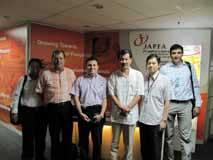End-users and feed millers in Indonesia and Vietnam are quickly learning the benefits of utilizing U.S. sorghum in their animal feed rations. Working to introduce U.S. sorghum as an alternative feed ingredient, Alvaro Cordero, U.S. Grains Council manager of international operations, and Dr. Joe Hancock of Kansas State University, traveled to Indonesia and Vietnam this week to promote U.S. sorghum as a viable feed ingredient for use in poultry and swine rations.
Currently, the use of sorghum by the countries’ feed millers has been practically nonexistent.
“The addition of sorghum to the repertoire of feed ingredients used would be highly beneficial to the region as sorghum currently has a zero percent import tariff in Indonesia and a 5 percent tariff in Vietnam,� Cordero said.
Seminars and workshops funded in part by the United Sorghum Checkoff Program enabled Cordero and Dr. Hancock to present the latest updates regarding the nutritional value of sorghum and demonstrate its competitiveness in feed formulations.
Indonesia’s meat production is dominated by its large poultry sector, which accounts for 75 percent of total feed demand. Indonesian poultry consumption has been growing 6 percent annually on the back of steady economic growth and increase in purchasing power among consumers. Feed production has also been growing alongside feed demand at an estimated rate of 7 percent per year. These fundamentals add to the growing prospect of Indonesia as a consistent importer of U.S. feed grains, such as sorghum.
Vietnam is also a growing market for U.S. sorghum and corn as local and regional corn crops are of poor quality, according to Cordero. “While the import tariff for U.S. yellow corn and sorghum is 5 percent, local corn is priced relatively high at $300 per metric ton. Import price for U.S. corn and sorghum is around $315 per ton CIF (Cost, Insurance and Freight). As Vietnam continues to develop, people will pay the extra price for a better quality product.�


